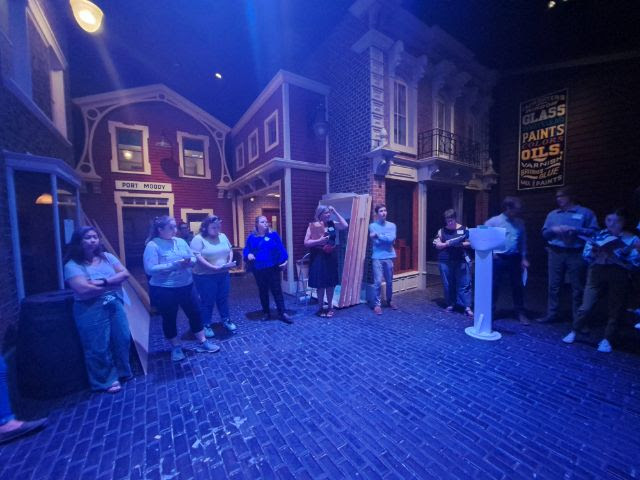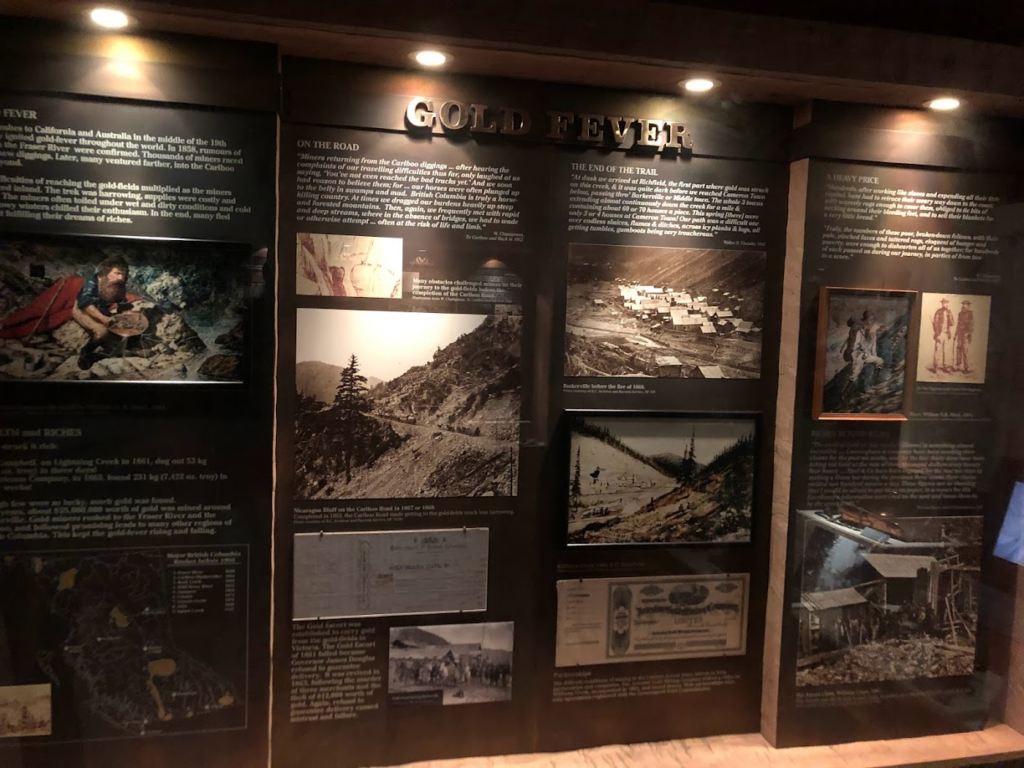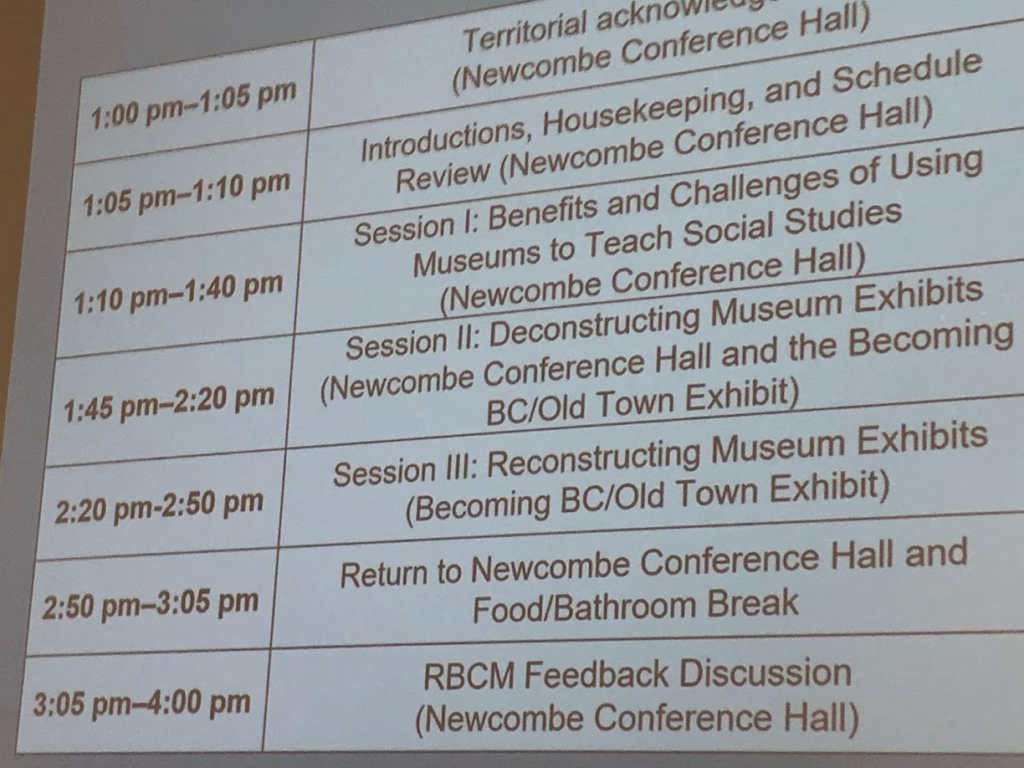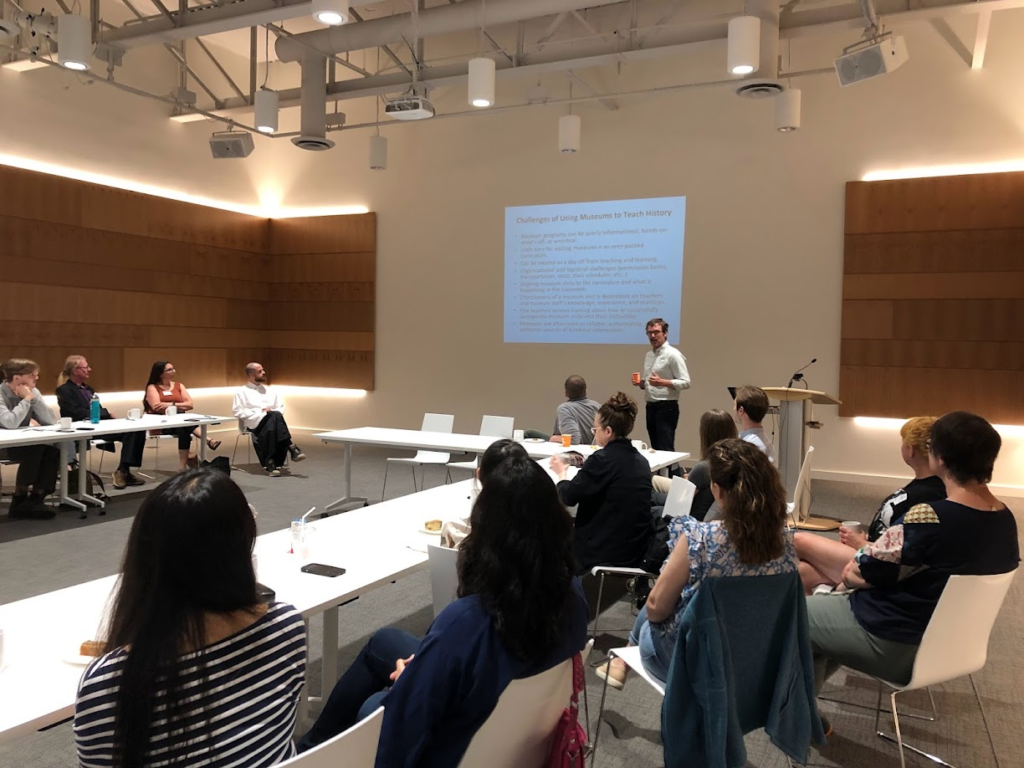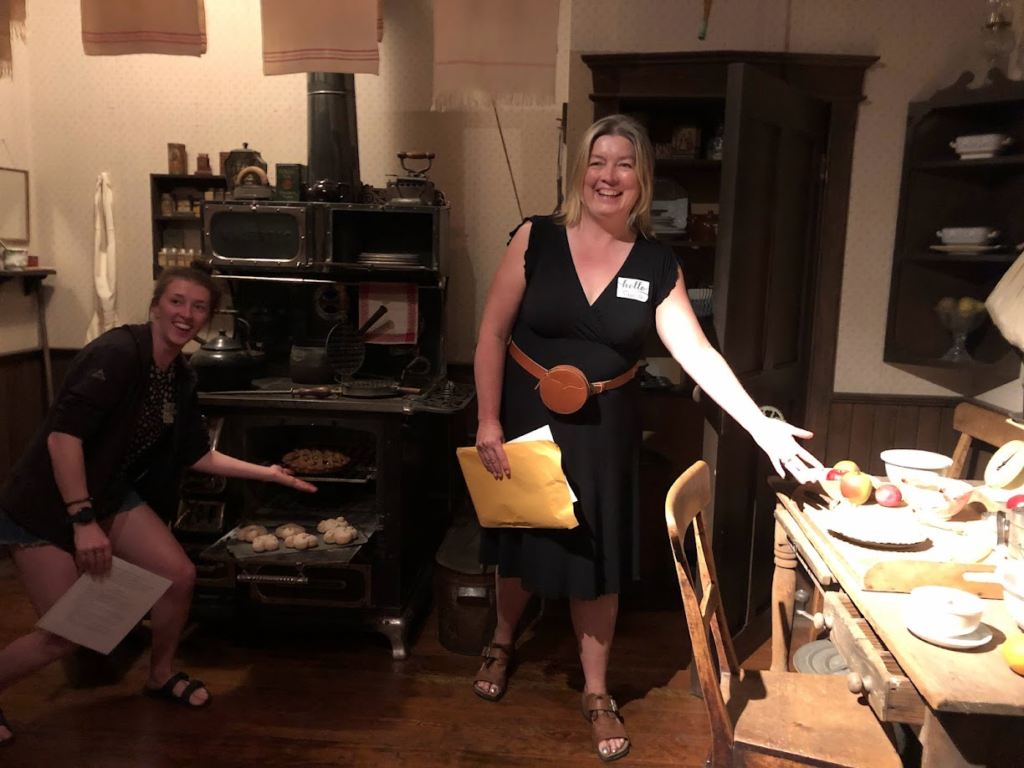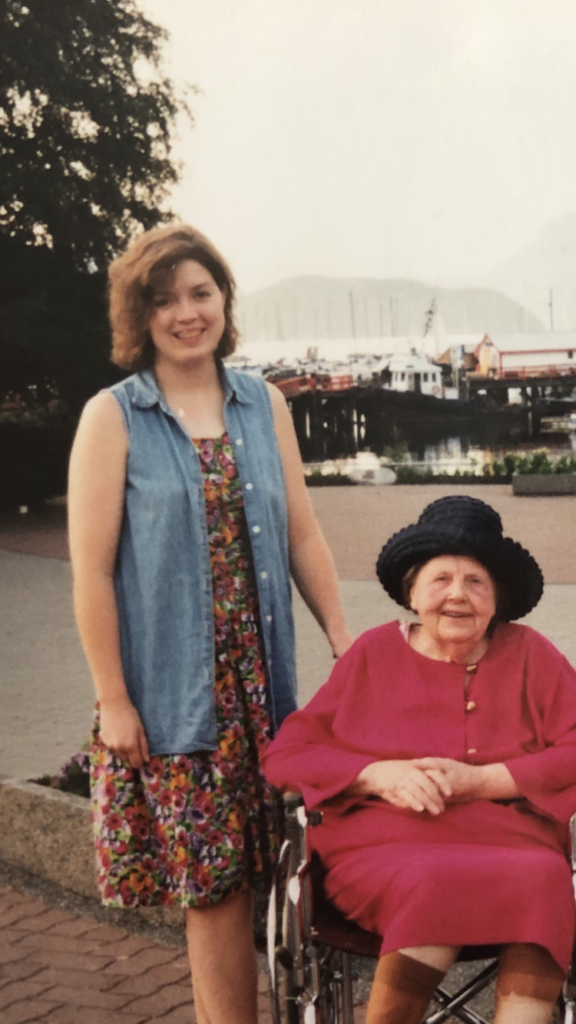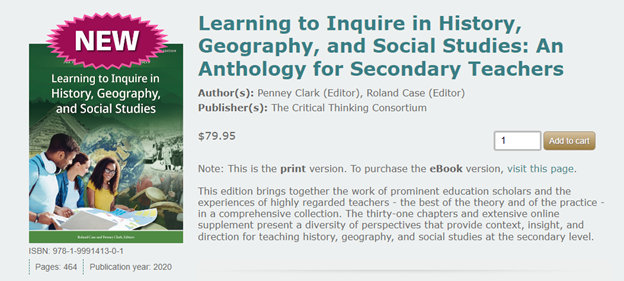
Source: CBC News Interactive. Click for Current Results: https://newsinteractives.cbc.ca/elections/british-columbia/2024/results/
This image was BC Election Results as of 10am, Sunday October 20, 2024. Dark Blue = Elected Conservative. Light Blue = Leaning Conservative. Dark Orange = Elected. Light Orange = Leading NDP. Bright Green = Elected Green.
“What happened in Saturday’s Election?”
Monday morning will see students arriving back in classrooms across British Columbia, and many of them will be hoping to have this conversation in class. Nearly 180,000 of them had voted last week in Student Vote parallel elections, and hopefully many of them will have gone along with parents when they voted or watched some of the coverage of votes being reported, with some having volunteered for candidates or – for those 15 or over – having even worked as election officials through Election BC’s Youth at the Booth program.
I loved teaching elections in my 22 years in the classroom, and it’s something I miss now that I’m a teacher-educator. The “atmospheric river” that missed my house in north Nanaimo has arrived now, so while I wait for conditions to improve to take my dog out, I thought I would write this to share some of my ideas to build your students political data literacy through the still-evolving election results.
Here are some questions to explore, and associated strategies:
Who Won the Election?
I will have to update this blog I suppose, as the view from the day after doesn’t allow us to answer this question yet. The preliminary count finished Sunday afternoon, but the final count will not be until October 26. This will include ballots that were not included in the initial count – about 49,000 of them. There will also be recounts in two ridings that had less than 100 votes difference, with the potential that others could be requested.
There are several very close races across the province at the moment. Among these votes are ones that were cast early at Elections BC offices, before Advance Voting started. Those might have been motivated voters who knew they would be away for voting, plus people working on campaigns or for Elections BC during regular voting.
This is what the results look like Sunday afternoon:

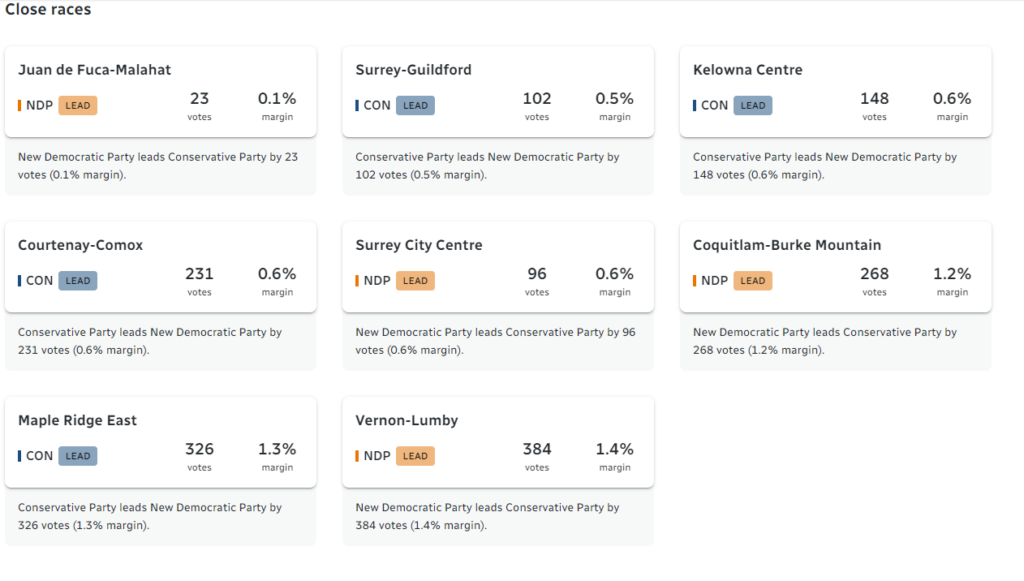
For your students’ understanding of how elections work in our system, I think the most important thing to stress with these emerging results is that who wins is not based on the popular vote, or what percentage of British Columbians across the province voted for each party.
We had 93 separate elections yesterday, electing 93 MLAs. While usually the party that wins the popular vote also gets to form government, it doesn’t always work out that way.
Idea: Have students look at the results of the 1996 BC election. Have them try to figure out who won.

No – not the BC Liberal Party. They won the popular vote, but the NDP had the most candidates elected.
How did that happen? The BC Liberals won by big margins in some ridings, but the NDP won enough close races, where they came first of a few candidates.
This is just how our first-past-the-post system works. It’s all legit, though this could be an opportunity to spin off into looking at different electoral systems and the benefits and drawbacks of different options for electoral reform. You could contrast this with the results of the 2001 election, which saw the BC Liberals win 77 of 79 seats with less than 58% popular vote, the NDP reduced to two seats, and the BC Greens win no seats, despite receiving votes from over 12% of BC voters.
Comparison to 2017
The example from history that might be most relevant to what will happen over the coming days and weeks comes from May 09, 2017, when the BC Liberals under Christy Clark just edged out the NDP, under John Horgan, in popular vote and won 43 of 87 seats to the NDP’s 41 seats, but ultimately an agreement between the NDP and the 3-member Green Party caucus, then lead by Andrew Weaver, saw the NDP form government.
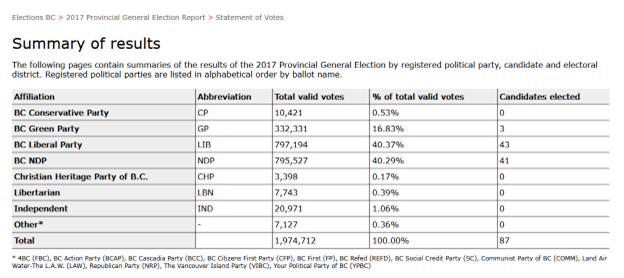
I can’t do justice in just a couple of sentences in how all that went down and the role of the Lieutenant Governor, so if you’d like a reminder, check out this end of 2017 look back at the events from Global News.
While the election was held on May 09, it took several weeks for the government to be determined. As the BC Liberals were the incumbent government, Christy Clark had the first opportunity to test the confidence of the legislature. When the 1st Session of the 41st Parliament began in the last week of June, the government would face its first test. John Horgan brought forward a non-confidence motion which passed 44 (with Greens supporting NDP) to 42.
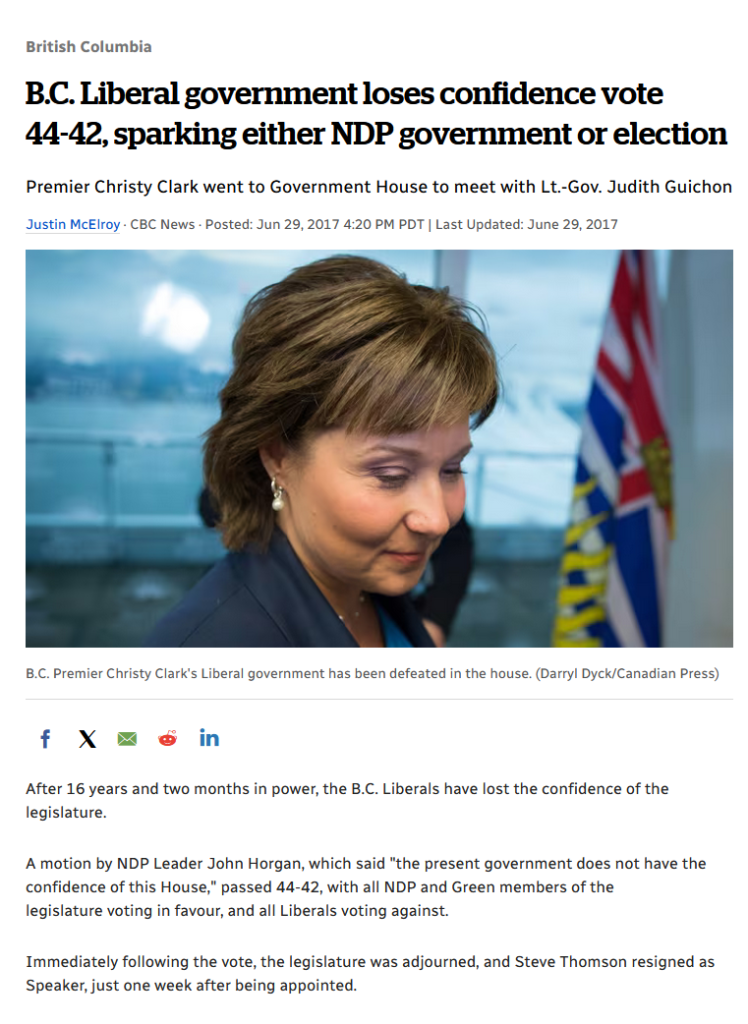
Source: https://www.cbc.ca/news/canada/british-columbia/bc-liberals-fall-non-confidence-1.4185005
Fun side note…. My friend Cathy and my son Henry (then at the end of grade 10, and now a future 2025 legislative intern) and I secured seats in the visitor’s gallery through our then-MLA, Leonard Krog. We were holding up one of our tickets to the gallery, knowing the non-confidence motion we expected to see would likely be historic.

How did students vote in comparison?
As soon as polls close each election, CIVIX releases data on who students would have voted in Student Vote.
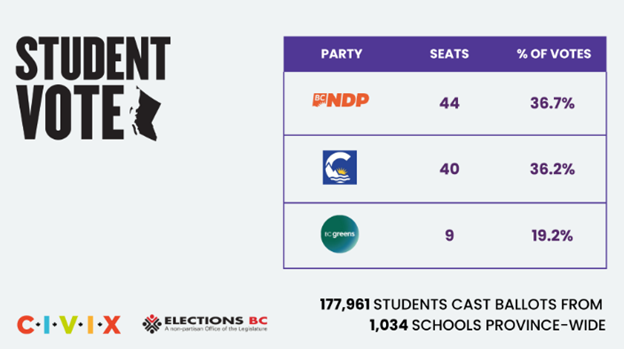
On their website, you can drill down to look at the data from the riding, and at each participating school. This can make for some interesting comparisons to the community as a whole.
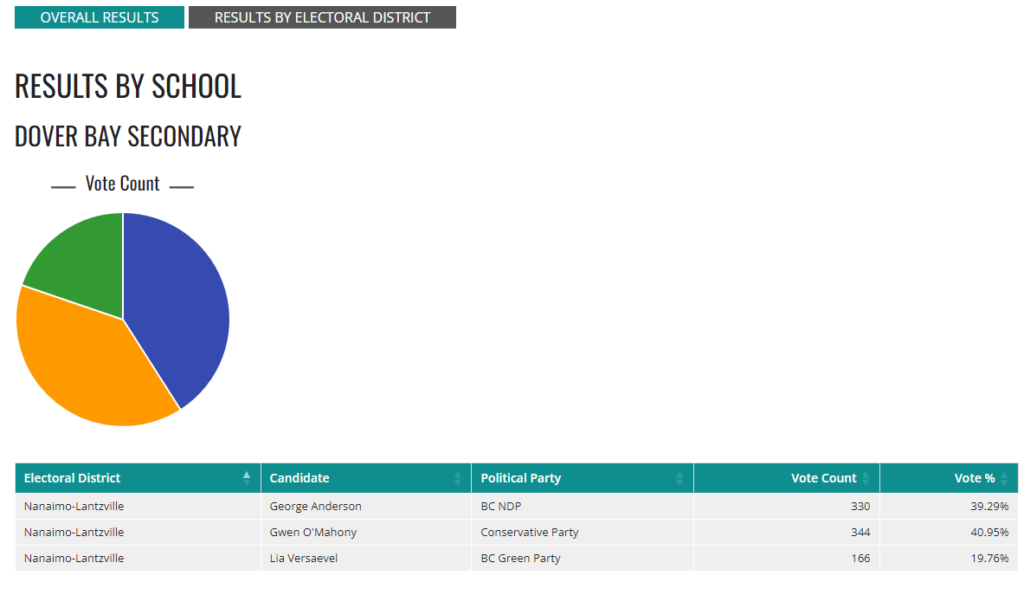
Where geographic thinking meets political data
The initial image that I shared in this blog, of the coloured map of ridings, can be an interesting provocation for some geographic thinking for students. You could…
- Get them to list everything that they observe first, without making any inferences. They might notice the colours, and that the lines show bigger pieces and smaller pieces, and that the colours cluster in different place.
- Get them to generate questions – what are they wondering about? Maybe they are curious what the colours mean, or why some pieces are bigger than others.
- Go over what they notice and together try to answer their questions, then…
- Try to make inferences. There is some interesting stuff you can get into if they start noticing where parties are more and less popular, etc. You can go deeper by looking at maps the show other information, such as the types of industries in BC and other demographic details.
Hopefully you will also be following the US presidential election with students this fall, so you can also look at this fascinating pair of maps from the 2020 election. Get students to look at one, then the other, and discuss how that impacts their understanding of how Americans voted.
First the one that is very recognizable on CNN, and that looks like the map that Richard Zussman was using to explain ridings on Global BC coverage:

With the US electoral college having most states as “winner take all” the country looks very divided, with an image that entire states are filled solely with Republicans (red) or Democrats (blue). Just like our map gives the viewer an image that everyone in the Nanaimo ridings are New Democrats and everyone in the Fraser Valley vote Conservative.
Maps are made by people who choose what information to include and exclude, and what labels and colours to use.
Contrast the image of the US with the same data from 2020, but now at the county level.
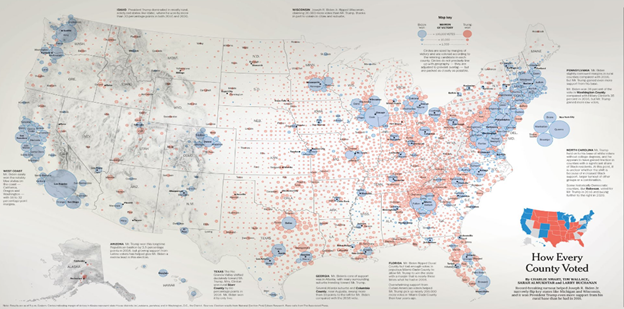
Same election, but you get a lot of different information about the country. See what they notice…. Urban rural divide, with cities more blue. States have diversity within them, even if all electoral college votes go to one presidential candidate…. population distribution etc.
The final report of the BC election will show poll by poll results. You can look at your riding and look for patterns. What neighbourhoods voted which ways?
Voter Turnout Inferences
At the end of the final day of Advance voting (Wednesday, October 16) a record had been set; over a million British Columbians had already voted! In some ridings, more than 1/3 of registered voters cast their ballots ahead of time. There was discussion about whether this would bode well for having higher voter turnout than we have seen in the last few elections, but ultimately only 57.39% of registered voters had cast ballots in the initial results (so this will go up a smidge for final count), which is on-par with the last 5 elections, but lower than voter turnout used to be.
Some ideas for discussion questions or data crunching:
- An atmospheric river hit some ridings really hard on election day, with the North Shore and parts of Surrey seeing flooded roads, while my “riding to watch” – Nanaimo Lantzville seeing a few sprinkles in an otherwise cloudy day. Could weather have impacted voter turnout in some key ridings? Could it have made a difference in the outcome? Who would have been more motivated to get their rain boots on and brave the elements? Voters who were really wanting a change? Voters who were really inspired by a particular local candidate? Voters wanting to vote against a candidate or party they oppose? Voters who are really committed to a responsibility to vote?
Your students could do some interesting dives into data comparing rain amounts to voter turnout and outcomes. Some key learning would be consider these “inferences” and to try to judge how plausible they might be. Is a relationship between one factor and another potential causal, or is that too much of a stretch. We can’t know, but which inferences could be reasonable?
2. Why is our turnout not higher? You can look at voter turnout over time at different levels of government and find trends, as well as studies by Elections Canada and Elections BC that have surveyed non-voters to ask why they don’t vote. Some democracies around the world have mandatory voting, with small fines for those who don’t vote. What would be the benefits and drawbacks of that kind of system?
The interesting what ifs… vote splitting, independents, strategic voting etc.
Some of the most interesting analysis in the wake of this election involves looking at ridings that had interesting or surprise outcomes, and considering the “what ifs”.
This election was the “craziest” that veteran BC reporter Keith Baldrey has said he has ever covered, and he began in 1983. Between the implosion of BC United (former BC Liberals) to the meteoric rise of a BC Conservative Party that was polling at less than 2% for most of my lifetime, to the scandals around the views and social media posts made by some of their candidates, this was a doozy.
If you feel like you need some more background, I would recommend this Globe and Mail Decibel podcast interview with their legislative reporter Justine Hunter.
Your students can look to some of the ridings and see if they can spot any vote splitting.
- There were some ridings where the independent candidate (usually someone who was supposed to run for BC United and didn’t get a chance to) earned more votes than the difference between the first and second place finishers.
- There are also ridings where they Green Party candidate earned more votes than the difference between the NDP and Conservatives.
Get them to play with looking at some “what if” scenarios with close ridings, but then follow up.
It can be tempting to just imagine “if that person didn’t run, then candidate X would have been elected”. Talk with students about how that isn’t necessarily the case.
Sometimes having an independent, or perhaps a Green candidate, would have brought people out to vote who would have otherwise stayed home if they had only two choices. The Greens have often argued that they don’t take votes away from anyone else, but that they increase the pool of voters.
Who a voter’s second choice would be in an election isn’t always exactly crystal clear. I found the firm Earnscliffe’s analysis of voter intentions quite interesting. They report has a lot of this kind of data to look at:
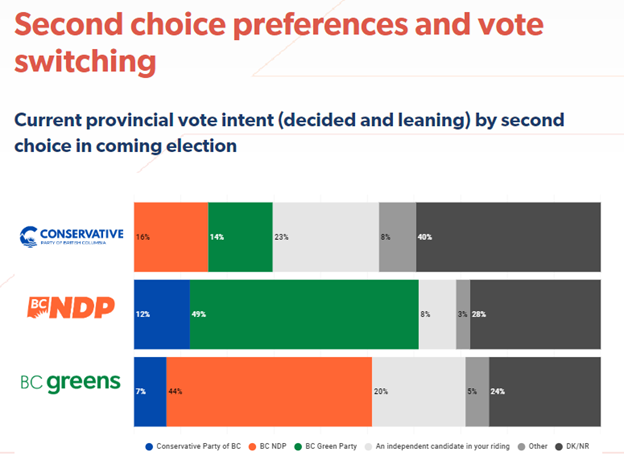
It’s interesting to look at who they 2nd choices were for the people they polled, but that for some, there was no second choice as they picked DK/NR (don’t know – no response). 24% of Green voters went DK/NR, and they didn’t have a candidate in every riding.
Polling Data
If you are working with secondary students, one of the types of political data literacy that I think is quite important is to understand how opinion polling works, and the impact that it can have on voter behaviour. We are well, well past the days when we would all dutifully pick up when a call came in on our landlines, then answer the questions of the polling firm employee on the other end of the line. Firms these days use either online panels (that people have to sign up for) or IVR, or “robocalls” where a computer calls you and hopes that you will pick up even instead of screening out their call. Firms balance the results they get with methods as they know they are getting fewer youth, etc., but are often missing whole segments of the population.
So it can be interesting to look with your students at the polls that were released to the public. Which ones were more successful in capturing what happened? What methodologies did they use? What about polling aggregators like this one? What did they get right and what did they miss? How is this data different?
The excellent BC podcast Hotel Pacifico, hosted by Kate Hammer, Mike McDonald, and Geoff Meggs, has been an excellent source of insight into polling data and how we should interpret this. Mike crunched the numbers in each of the episodes they did daily during the campaign, and I’m sure we’ll here more analysis of how the polling did when they drop their post-election episode.

Polling can influence voter behaviour, as it can nudge us to join a bandwagon, jump off a sinking ship, vote strategically, make sure to line up in the rain to vote, or stay home in our jammies. Understanding what’s happening under the hood isn’t just for political science and stats nerds… it’s something all voters should be aware of.
Last Words
The “evidence” curricular competency in Socials connects to historical evidence, but some of the most authentic feeling evidence work connects to political data literacy and geographic thinking. Elections are a great time to jump in.
I did this kind of work after each election over a couple of decades. I promise the students will be more interested than you might imagine they would be!

